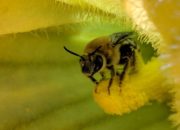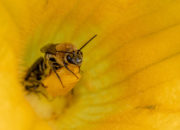In Vermont, this species is closely tied to cultivated squash, having followed Native American cultivation of these crops from the South Western US and Central America. It only collects pollen from the large-flowered squash species (i.e. pumpkins, winter squash, zucchini). If you plant squash, they will almost certainly find it.
Currently most sources still refer to Peponapis as a stand-alone genus, but new evidence has suggested it is better treated as a subgenus of the Eucera. Expect the name to change in the future.
Identification: Slightly larger than a honey bee and covered with dense hairs – mostly pale orange on the thorax with off white bands on the abdomen. Their clypeus is slightly swollen with a yellow rim on males.
Similar Species: Squash Bees are in the Long-horned Bee tribe, and are similar to Long-horned Bees (Genus Melissodies), though the later rarely, if ever, visits squash. Honey Bees and Bumble Bees are common visitors to squash that are about the same size. Honey Bees can also be a similar color, but are much less hairy with shorter antenna.
Known or Suspected Parasites: Host to the distinctive Squash Longhorn-Cuckoo (Triepeolus remigatus) which is uncommonly found in New England, but present around at least one VT farm and a community garden.
Global Status: Secure (G5)
Vermont Status: Not Ranked
For more information, visit the following links:
Discover Life
Living Atlas Species Page
Distribution: To see the global distribution, check out the iNaturalist account, and toggle the GBIF layer on the map.








